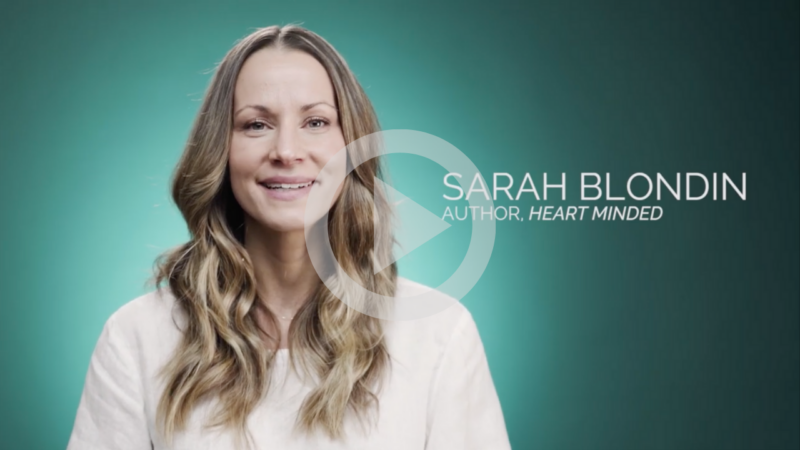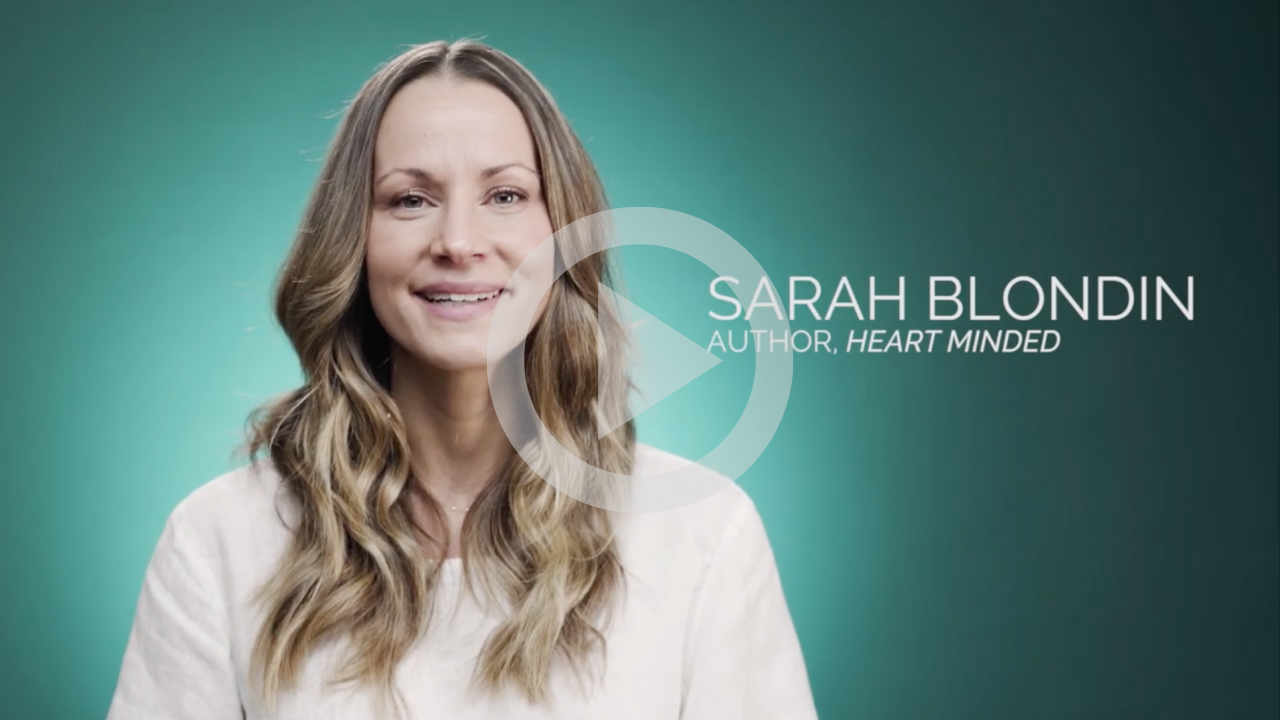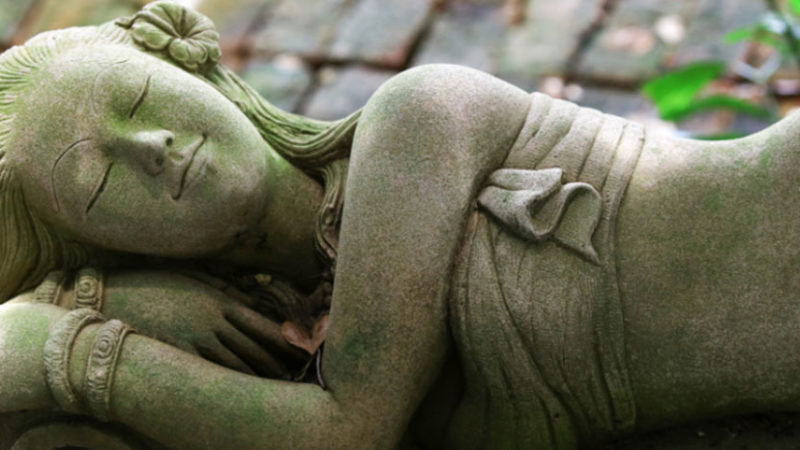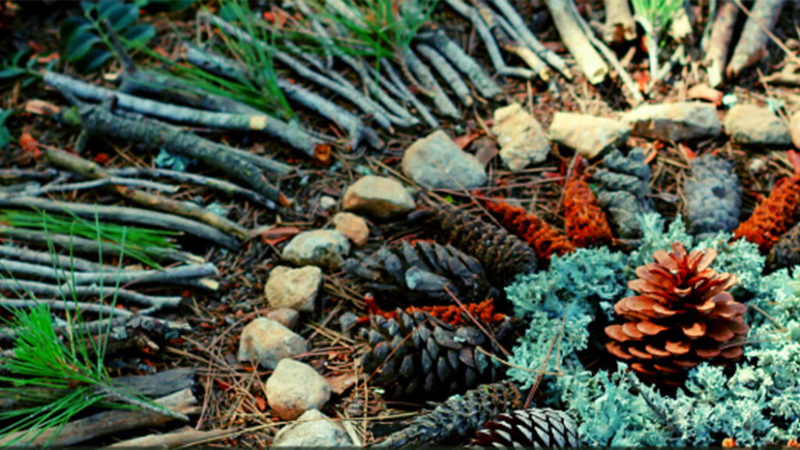Building the Bridge Between the Heart and the Mind
How can we drop what we are holding on to, if we do not first look for the hand that is grasping so tightly?
Have you ever noticed that you have two distinctly different personae and tend to vacillate between them?
One is very rigid and concerned with the outcome of everything. It worries and frets, its gaze mostly downcast. It doesn’t rest easily, even keeps you up at night sometimes. It acts almost like a dog chasing its tail. It circles obsessively over every detail and unknowable outcome, chasing the same things in a constant repeated pattern. It is cunning, convincing, and tyrannical in nature. It is feverish and ungrounded. Changing, morphing, and flopping from one story or idea to the next. This is your unharnessed mind. The persona you take on when your mind is not connected to the compass of the heart.
For most of us, that’s the dominant persona. But the other aspect of you, as if by some divine intervention, will from time to time slip past the censor of the mind and cheerfully take over your being with its boundless and uninhibited spirit. This personality doesn’t worry. Its face is often lifted, looking in wonder at the shifting sky and swollen moon. Lips curled into a slight smile. It is fluid and flowing, as if it’s on a river of unending joy. It acts like water and reflects light. You feel buoyant. This is your heart-centered self, your true self.
Because most of us moved into our mind long, long ago as a way of protecting our hearts, we now live most of our time in that rigid, concerned first persona. Without even realizing it, we allow our minds to stand between us and our true nature. We have no (conscious) idea how much our minds are acting as a defensive block against our soft and tender core, constantly at work trying to find ways to keep us from feeling, from hurt, from heartache. The price we are paying, however, is that we are also kept from accessing source.
In order to be heart minded, we need to bring the heart and mind into harmony and partnership with one another. For this to happen, we have to train the mind not to fear and close off from the heart, and instead, serve our heart and implement its wishes. In order to do this, we have to undo our mind’s association of feelings of the heart with hurt and harm. In situations that would ordinarily have us retreat or retaliate, we need to remain conscious of what’s happening and choose to soften and lean into our heart’s center. Each time we practice this softening, we send a new message to the mind that signals that we are safe, willing, and wanting to live in this more open, more sensitive way.
Over time, if we are resolute in our intention to step into our heart, our mind will become less rigid in its defenses against feelings and tenderness, and gradually we will become more heart centered.
Remember, we are not trying to pit the heart and mind against one another; we are trying to marry their aptitudes.
Let’s say a wave of anxiety washes through you. You notice your mind begin to race and attach to fearful thoughts. The anxiety then morphs into panic, which courses through you and makes you feel like jumping out of your skin. You begin reaching for an escape, resorting to some form of substance or distraction that can act as a numbing balm.
What just happened? Because you avoided your distress, you are only slightly comforted. A part of you remains braced under the distraction, in fear of the next time this could happen. Your mind’s instinct to protect and defend has been confirmed.
Your heart is neglected and still aching.
But let’s say a wave of anxiety washes through you and instead of looking for an escape route, you go to a quiet room to confront the feeling. You let go of the notion that something is wrong and respond as if something very right is taking place. You know some part of you is calling out for your love and attention.
Let’s say you close your eyes and open your heart to the bigness of the feeling. You create space around it simply by looking without resistance at its contours. You know the only antidote is self-love and hospitality. The mind stops racing away from the distress, which makes room for the heart to begin healing and soothing the body. Your mind learns a new route. You are gifted with courage and resilience.
The only difference between these scenarios was one simple choice: to remain a bystander as the mind continues to ignore the call of the body and heart or to act in ways that support leading from the heart, so the mind can follow.
The two can be wonderful allies if we let them.
As we become heart minded, we begin transforming our human experience from something out of our hands to something very much in them. We begin to cultivate joy instead of haphazardly stumbling upon it when we are willing.
Each moment, our bodies are counseling us to make choices that bring us closer to love. The wisdom of the heart and body is there for us, always, if we listen and let it lead.
For a guided practice in learning to stay in our hearts during difficult times, follow along with Sarah in this video.
This is an adapted excerpt from Heart Minded: How to Hold Yourself and Others in Love by Sarah Blondin.
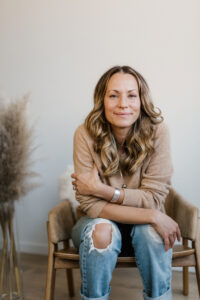
Sarah Blondin is an internationally beloved spiritual teacher. Her guided meditations on the app InsightTimer have received nearly 10 million plays. She hosts the popular podcast Live Awake, as well as the online course Coming Home to Yourself. Her work has been translated into many languages and is in use in prison, recovery, and wellness programs. For more, visit sarahblondin.com.
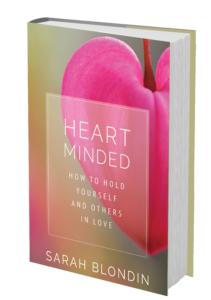
Learn More
The Basics of Natural Awareness 101: Dropping Objects

There are three deliberate mental shifts you can make during classical mindfulness meditation that can help point you toward natural awareness: relaxing effort, broadening attention, and dropping objects.
If you have not read the previous two steps, you can find Relaxing Effort and Broadening Attention on our blog.
Dropping Objects
When you’re practicing classical mindfulness meditation, probably the most important shift you can make to invite in natural awareness is to move your attention from objects to objectless-ness. Now what on earth does that mean?
Objects of meditation are, simply put, the things we focus on, such as the breath, body sensations, emotions, thoughts. An object can also be something outside us, like another person, sights, or sounds. Any kind of thing can be an object of meditation. Taking something as the object of our awareness is basic to classical mindfulness meditation, as you saw in the previous chapters. Focusing on objects and attending to them is generally how we live our life as well.
Objectless awareness, typically developed in meditation and uncommon in daily life, is when we focus less on the objects of awareness and instead focus on the awareness itself. There will be objects arising in our meditation—thoughts, emotions, sensations, for example—but since they are not the focus, they are less distinct, and we become aware of awareness itself. So instead of our anchor being our breath, for example, our anchor is awareness itself.
People tend to experience objectless awareness in three different ways: that in which everything is contained, that which knows, and that which just is.
That in which everything is contained. Broadening attention from a narrow focus to a more panoramic perception is closely aligned with the experience of objectless awareness as that in which everything is contained. You will notice me using analogies like “Our mind is like the sky, and everything in it is like clouds floating by.” This helps me convey the idea that awareness contains everything. So when we turn our attention to the sky-like nature of our mind, noticing the boundless space around things, we are noticing the field of awareness in which everything is contained. Some people experience objectless awareness in this way.
Think about looking out a window at a busy street. When we look out the window, we take in the full view in a relaxed way. Rather than specifically focusing on individual vehicles, we somehow are aware of everything that is happening simultaneously, and our vision seems to contain everything.
That which knows. The second idea that objectless awareness focuses on is a little tricky. Most of us are used to focusing on objects when we meditate, but what happens when we make the shift to noticing that which is being aware—to seeking the knower? Oftentimes this shift can feel quite joyful and freeing. Many of the practices in the book move us toward awareness of awareness, as you will see. If you start searching for the knower, what do you find?
The idea is that we can notice things, and we also notice the thing that notices things. We can take our attention from an outward focus on objects and turn it inward, as if we are reversing our attention—trying to move from that which we are aware of, to that which is aware of what we are aware of.
This is excerpted from The Little Book of Being: Practices and Guidance for Uncovering Your Natural Awareness by Diana Winston.


Diana Winston is the director of Mindfulness Education at UCLA Semel Institute’s Mindful Awareness Research Center (MARC) and the coauthor, with Dr. Susan
Smalley, of Fully Present: The Science, Art, and Practice of Mindfulness. She is a well‑known teacher and
speaker who brings mindful awareness practices to the general public to promote health and well‑being. Called by the LA Times “one of the nation’s best‑known teachers of mindfulness,” she has taught mindfulness since 1993 in a variety of settings, including hospitals, universities, corporations, nonprofits, schools in the US and Asia, and online. She developed the evidence‑based Mindful Awareness Practices (MAPS) curriculum and the Training in Mindfulness Facilitation, which trains mindfulness teachers worldwide.
Her work has been mentioned or she has been quoted in the New York Times; O, The Oprah Magazine; Newsweek; the Los Angeles Times; Allure; Women’s Health; and in a variety of magazines, books, and journals. She is also the author of Wide Awake: A Buddhist Guide for Teens, the audio program Mindful Meditations, and has published numerous articles on mindfulness. Diana is a member of the Teacher’s Council at Spirit Rock Meditation Center in Northern California. She has been practicing mindfulness meditation since 1989, including a year as a Buddhist nun in Burma. Currently, Diana’s most challenging and rewarding practice involves trying to mindfully parent an eight‑year‑old. She lives in Los Angeles.
For more information, visit dianawinston.com and marc.ucla.edu.
Buy your copy of The Little Book of Being at your favorite bookseller!
Sounds True | Amazon | Barnes & Noble | Indiebound

I Did a 40-Day Rest Cleanse and Here’s What Happened
For 40 days, I had the most soulful rest. And I did it in the comfort of my own home, with a full-time job, a family, and a social life.
Every day I awoke around 5:30 am and tiptoed to my Rest Cave (set up in a corner of our spare room). I laid on my back on an exercise mat (under my favorite blanket with a sleep mask) and plugged earbuds into my phone. Then I hit play on Karen Brody’s Daring to Rest yoga nidra meditation and let her soothing guidance lull me into a state of deep rest—or as Karen puts it, a return to myself. If you’re not familiar with yoga nidra, it’s a meditative practice for entering one of the deepest states of relaxation imaginable. And you do it lying down.
I’m not a morning person, but getting up to lie down (ironic, right?) was lovely. The stillness of the early morning quickly became my friend.
For the first 15 days, I listened to the Rest Meditation (20 minutes) to shed physical exhaustion, followed by 15 days of the Release Meditation (30 minutes) to let go of limiting beliefs. The last 10 days consist of the Rise Meditation (40 minutes), allowing life purpose exhaustion to lift, so that you can hone in on your true-hearted desires. Every five days I read a chapter in the book itself, Daring to Rest, for insight into what I was experiencing and supportive practices.
Gradually these aspects of my life began to shift—providing a depth of experience new to me, and oh so, beautiful.
- An underlying sense of sweetness in my day. I discovered a natural flow to my day, felt light and at ease in my skin, and second-guessed myself less.
- Deep intuition. Karen guided me to breathe in through my heart, then follow my breath, see where it landed, and listen for what she calls a “soul whisper”—a word or image that offers a clue to how you’re really feeling. Some days all I could think about was my to-do list or obsess over a worry. But when my soul whispers did arrive, they were often crystal clear and I journaled about them.
- Patience and connection. Mornings were less frantic. When my seven-year old son had stressful moments getting ready for school, I felt calmer and more present for him. When we walked to the bus stop, my awareness of the outdoor world was more acute—the blue sky, cloud formations, the crescent of a morning moon.
- Craving control. On days when I felt overwhelmed or anxious, my inclination to relieve those feelings with a glass of wine or binging on television lessened. Sometimes I would simply sit, gaze outdoors, and do nothing more. In those moments, I loved not feeling the need to do anything—not clean, not sort the mail, not check Facebook. I began to understand rest outside of my Rest Cave.
- A connection to beyond. This was a big one. Karen calls it your “council of women” and teaches you to summon it for love and support. It can be women in your circle, women who have passed, even women you don’t know personally. I saw my grandmother (who died before I was born) looking at me lovingly and felt my sister-in-law, who I’ve known since I was a baby, standing beside me. At times the feeling of these and other women was so strong that tears ran down my cheeks.
While my life became deeper and rosier, it was not until I went cold turkey for a few weeks that I realized just how powerful this rest cleanse was. I’ve always been someone who can go the distance, then neglect the sustaining part, like training for a half-marathon but not running for months after the race. And it’s so easy to fall back into old habits.
So now I’m learning how to translate this cleanse into an ongoing practice, for which Daring to Rest offers sound insights. My Rest Cave is an essential element. It’s not only a dedicated space for yoga nidra, but one for self-care in general—to journal, to listen to music, to just be.
Karen ends every yoga nidra meditation with the words, “Be good to yourself.” And in that spirit, I invite you to download her free Rest Cave Guide to create your own. And once you do, I dare you to rest and see what happens!
Christine Day has been a member of Sounds True’s sales and marketing team for more than five years and loves diving into our books on a personal level to learn both theory and practice. She also works on Sounds True’s children’s books and enjoys doing storytimes at her son’s elementary school.

A Grounding Meditation to Start Living From Your Heart
I would like to open with a grounding meditation. Feel free to listen to the meditation here or you can read along with the text below.
If I may, I’d like to guide you someplace warm. To an island not too far away. It won’t take much effort, just a few conscious breaths. And all I need for you to do is to stop. For this moment, stop seeking, stop solving, stop gritting and grinding. All you need is to close your eyes and receive.
Quiet now, like water or sand. Settle now, like dusk and dew drop. One breath in, one breath out. One breath in, one breath out. Reorient yourself to face toward what is immovable inside you. Just look now. Trust and you shall see. It is there, to the left of your right lung, tucked just under your left rib, a warm small island, beating like a drum. If you stand here long enough, you will feel the song inside being written, maybe even prayed over you. Moment by moment, it never stops.
Can you feel you are unlacing something? Or better, something is unlacing you? Can you feel the fight stopping? The fear quieting? Can you feel your edges becoming more like wind or water, rather than shale and stone? Can you feel the light coming? The waves of warmth rising?
Now move into this current of grace that your heart has created for you, and feel the great hush wash over you. Feel the substance of love holding your very atoms together. This is your heart, dear one. Never forget this is yours. Kneel here, whenever you are thirsty, whenever your feet are tired, or your hands are sore. Kneel here when you can’t see love any longer. Kneel here, dear one. Reorient yourself toward what is immovable in you.
My new book, Heart Minded: How to Hold Yourself and Others in Love, was written to help remind us, reconnect us, reorient us with our hearts. Through story and guided meditation, I lead you through the fraught and sometimes frightening places holding you separate from your heart. It is a journey of healing that teaches you how to see and feel not from the mind, but from the wise seat of your very heart.
Now more than ever, we are being asked to move into the consciousness of the heart. Where love, compassion, “at-one-ment” become our governing virtues. When we see through the eyes of the heart, when we become heart minded, we stand as a beacon of light, burning back the dark.
Please join me in the heart-minded revolution.
This originally appeared as an author letter to the Sounds True audience from Sarah Blondin.
 Sarah Blondin is an internationally beloved spiritual teacher. Her guided meditations on the app InsightTimer have received nearly 10 million plays. She hosts the popular podcast Live Awake, as well as the online course Coming Home to Yourself. Her work has been translated into many languages and is in use in prison, recovery, and wellness programs. For more, visit sarahblondin.com.
Sarah Blondin is an internationally beloved spiritual teacher. Her guided meditations on the app InsightTimer have received nearly 10 million plays. She hosts the popular podcast Live Awake, as well as the online course Coming Home to Yourself. Her work has been translated into many languages and is in use in prison, recovery, and wellness programs. For more, visit sarahblondin.com.
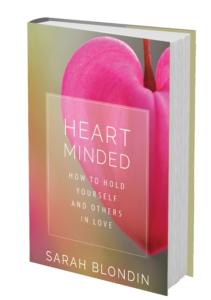
Learn More
Sounds True | Amazon | Barnes & Noble | Bookshop
Giving Thanks to the Earth
Many indigenous cultures refer to the more-than-human worlds as people. Clouds, trees, stones, plants—all belong to their own community, speak their own language, and have their own relationship to the spirit that moves through all things. The first time I recognized these more-than-human communities and felt their presence strongly as an adult was when I had spent a lot of time in the woods and became fascinated with trees. I noticed that in some places, many American beech trees grew together, while in other places, eastern hemlock congregated. In the beech groves, the simple-toothed leaves quaked in the breeze; their smooth, grey trunks reminded me of the mallorn trees from The Lord of the Rings. I couldn’t help but feel the presence of elves in those beech groves!
In the hemlock groves, the shadows were deep and the earth moist. The deep green boughs stretched and gently bobbed on the breeze, light, buoyant, and mysterious. The hemlock groves were hushed. Silence and watchfulness permeated the hemlocks’ shadows. Families of white pine created sun-toasted auburn carpets of needles, soft and aromatic in the afternoon light. Their trunks climbed high into the sky, and their bluish-green pine needles shone bright and happy in the sun. A feeling of optimism and joy seems to ring out when white pine needles shimmer in the sunlight. Under these mighty trees were perfect places to lie down or to sit and lean against trunks, perfect places to take in the tranquility of the land.
Looking into the distance, I could see patches of forest green on mountain slopes where communities of evergreens lived, and then the grey patches in the fall from oaks and maples that had lost their leaves. Suddenly it hit me: these are communities, tribes, families. Before this, I had not really seen or felt the profound reality of community that exists among trees of the same species, trees that congregate. Now, when I look out at hills or mountains in the distance, I see the tribes of tree beings whose presence creates a tapestry of color and texture all across our forested lands.
Trees communicate and support one another. Forest ecology expert Peter Wohlleben refers to the nutrient and information exchange that exists among trees in the microbial network underground as the “wood wide web.” There is evidence that trees work together to keep elder trees alive and that they warn one another of danger. We are symbionts with trees, relying on the oxygen they provide while they rely on the carbon dioxide we exhale. There is a give and take, a reciprocity, that binds us to the trees, plants, and other members of our earth community, all of whom share the atmosphere, nutrients, and waters of this living earth. To think of trees as objects denies what they are. To think that way minimizes and flattens the complex and mysterious reality of their “treeness.” This objectification of the living earth, whether it be trees, minerals, or animals, also flattens our consciousness and experience, causing us to miss out on so much of the beauty, love, and wonder to be found in relationship with the earth. When we think of the earth as composed of so many life-less objects, we give ourselves permission to treat them as such. If we take the time to slow down, to be mindful and observe the land, trees, and other crewmates of spaceship Earth, we strengthen our ability to see the reality of life’s living connections.
Reciprocity
Keep close to Nature’s heart … and break clear away, once in a while, and climb a mountain or spend a week in the woods. Wash your spirit clean.
JOHN MUIR
Rewilding is a way of seeing and being in relationship to life, and it can include learning ancestral skills for survival. Tom Brown Jr., a great tracking teacher, emphasizes the profound role gratitude and thanksgiving played in what he learned from his teacher Stalking Wolf, a Lipan Apache tracker and spiritual teacher. To truly feel and connect with the miracle of any living thing, any gift of the Creator, whether a piece of wood being carved into a sacred pipe or a plant or animal being harvested for food, one must honor the other being’s sacrifice and give thanks for what is received from that being. All of life is an exchange of energy. To live, all living things must consume, and in turn, be consumed. There is no escaping this.
Of all the world’s wonders, which is the most wonderful?
That no man, though he sees others dying all around
him, believes that he himself will die.
YUDHISHTARA, The Mahabharata
To be awake to the wonder of life is to be in a state of constant thanksgiving, for this breath, this bite of food, this caress of wind, this sunset, this chance to grow and serve others. A society whose people are involved in harvesting their food from their environment will likely be a culture that appreciates and that values thanksgiving. I believe that our collective loss of reverence for nature is in part due to our disconnect from the origin of our food. Pulling a potato or carrot out of the soil provides a sensual, embodied experience of taking life. When we take life, we have a natural inclination to want to give back, to restore balance.
We all need to embrace the ethic of thanksgiving again so that we don’t take the biodiversity of earth for granted. We can’t pretend that the water and air we pollute aren’t the water and air we rely on for our survival, for our health and well-being. A great start for a thanksgiving practice is with the breath, the thing we rely on most and most immediately. The birds who fly in the sky fly on our very breath. The air sweeps all around us, moving clouds, bringing snow and rain, making waves, and flowing in and out of our bodies with the oxygen that allows us to exist. The air we breathe moves the leaves in the trees, creating beautiful sounds that soothe our souls. We can go weeks without food and days without water but only a couple of minutes without the gift of breath. Throughout the world, there are cultures that hold the air and the wind as holy, as life-giving forces. The entire yoga tradition revolves around the fundamentals of breath, which can unlock expanded states of awareness and foster deep insights.
Giving Thanks
When I exhale, I know that the carbon dioxide flowing out of me will be absorbed by plant life and that the oxygen they exhale will flow into me. In my lifetime, I will ingest many living things, fruits, vegetables, animals, and water, and one day, my body will return to the earth, and other living things will eat me.
We are only stewards of our bodies for a time. Every seven or so years, every molecule in this body will have been replaced, so that the me I think of as me is stable only in my mind. Who I really am is living in a dynamic state of reciprocity with the cosmos. Our planet, which includes us, is made up of elements generated in ancient star explosions. So, when we walk barefoot in the grass, stand at the entrance to a forest, or look up at the cool moon on an autumn evening, we can acknowledge that we are not simply receiving beauty from a heavenly body, that there is more going on. Through mindfulness we can hold an awareness of our situation, one in which we are suspended between using and being used, between eating and being eaten, between enjoying and being enjoyed.
When did people stop talking to the earth? How does one thank the moon for being all that the moon is? I’ve made a habit of speaking to trees, stones, salamanders, the wind, and any other relative I see outside. I speak to everything in nature. Why? When I speak to the forest, it feels as if my words are resonating not only in the cavities of my human body but also through the air, back into my eardrums, and bouncing on trees, leaves, and stones. When spoken from the heart to the living earth, my words express love for what I experience as my greater self. I know that hemlocks and stones do not understand the English language; I am not anthropomorphizing them. Yet I feel fuller and more connected when I give myself permission to speak to the land. When I converse with the earth, sometimes the wind blows suddenly, as if in response, or a squirrel will throw a pine cone out of a tree, which also feels like some kind of answer. I don’t think we need to feel so isolated on this earth, so cut off and separate. We can honor our reciprocity with all of life by opening up the channels of communication with the more-than-human world.
Practice of Giving Thanks to the Earth
The next time you experience a perfect sunset, a refreshing walk through new fallen snow, or the gift of seeing a wild animal, consider offering a gesture of gratitude to the living earth. Drawing your hands to prayer in front of the heart and bowing to the light in that manifestation of the universe, you can simply say “thank you.” You might offer a small token, such as an acorn, pine cone, crystal, or small pebble, to show your thanks. You could also make an earth mandala, creating a circular symbol with natural objects you gather, and offer it with gratitude. As the days and months go by, the mandala will be received into the earth. You could also take a handful of water from a pond, lake, stream, bay, or ocean and speak your words of love and gratitude into the water, allowing your prayer to slip through your fingers and become one with the water of the earth. Maybe you would like to burn sage, palo santo, dried cedar, or another ceremonial incense of your choice, placing your intentions in the burning ember so that the rising smoke carries your prayer of gratitude and love to the heavens. These are small gestures, but they are powerful. These actions build a habit of focusing on the many ways we are in a deep state of interbeing with all of creation.
This is an excerpt from Rewilding: Meditations, Practices, and Skills for Awakening in Nature by Micah Mortali.

Making the darkness conscious
Much is being said these days about spiritual awakening, and the causeless joy, clarity, and peace that are inevitable milestones of the inner journey. Not all that much is mentioned, however, about the disappointment of awakening, or of the ways it can break our hearts, cracking us open to the reality of the crucifixion, the resurrection, *and* the transfiguration we are likely to encounter along the way. In the full embrace of life—right inside the yucky, messy, shadowy nether regions of the heart—we are invited to meet the wholeness of what we are, which includes the dark *and* the light, the movement of separation *and* union, and the entirety of what it means to be an embodied human being.
As Carl Jung so poignantly reminds us, we do not become enlightened by “imagining figures of light, but by making the darkness conscious.” He went on to say that the integral journey of the dark *and* the light is one that is often “disagreeable” and thus would never be popular. I believe Jung is offering very important guidance for us and the voyage of the heart in contemporary times.
The ancient path of love may never conform to our hopes, fears, dreams, and fantasies, for it is emerging in the here and now as an emissary of the unknown itself. Let us rest in the aching truth that one of the primary roles of the beloved is to seed deflation in the field of separation. Yes, awakening may always be a disappointment, from the perspective of egoic organization. In this sense, the journey is eternally hopeless, but it is in the creation of a home for our hopelessness—and allowing it to be illuminated within us—that we are finally able to step into a world beyond our wildest imagination.
As we journey together as fellow travelers, let us find a way to embrace both the joy *and* the heartbreak of spiritual awakening, and bear witness to the wisdom shining out of our immediate experience, whether it appears as sadness, bliss, despair, or great joy. It is true that grace will appear in both sweet *and* fierce forms, but regardless of its particular manifestation, it is still grace, sent from beyond to open us to the radiant fullness of being.
– Matt Licata, from the Preface to the forthcoming, It’s Okay to Be Broken: Embracing the Joy and Heartbreak of Spiritual Awakening.


